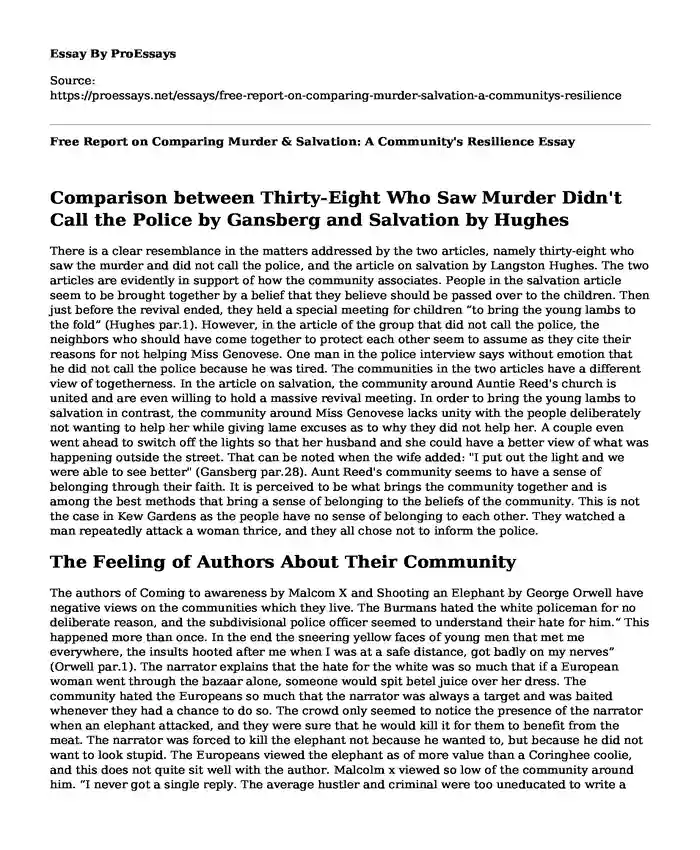Comparison between Thirty-Eight Who Saw Murder Didn't Call the Police by Gansberg and Salvation by Hughes
There is a clear resemblance in the matters addressed by the two articles, namely thirty-eight who saw the murder and did not call the police, and the article on salvation by Langston Hughes. The two articles are evidently in support of how the community associates. People in the salvation article seem to be brought together by a belief that they believe should be passed over to the children. Then just before the revival ended, they held a special meeting for children “to bring the young lambs to the fold” (Hughes par.1). However, in the article of the group that did not call the police, the neighbors who should have come together to protect each other seem to assume as they cite their reasons for not helping Miss Genovese. One man in the police interview says without emotion that he did not call the police because he was tired. The communities in the two articles have a different view of togetherness. In the article on salvation, the community around Auntie Reed's church is united and are even willing to hold a massive revival meeting. In order to bring the young lambs to salvation in contrast, the community around Miss Genovese lacks unity with the people deliberately not wanting to help her while giving lame excuses as to why they did not help her. A couple even went ahead to switch off the lights so that her husband and she could have a better view of what was happening outside the street. That can be noted when the wife added: "I put out the light and we were able to see better" (Gansberg par.28). Aunt Reed's community seems to have a sense of belonging through their faith. It is perceived to be what brings the community together and is among the best methods that bring a sense of belonging to the beliefs of the community. This is not the case in Kew Gardens as the people have no sense of belonging to each other. They watched a man repeatedly attack a woman thrice, and they all chose not to inform the police.
The Feeling of Authors About Their Community
The authors of Coming to awareness by Malcom X and Shooting an Elephant by George Orwell have negative views on the communities which they live. The Burmans hated the white policeman for no deliberate reason, and the subdivisional police officer seemed to understand their hate for him.“ This happened more than once. In the end the sneering yellow faces of young men that met me everywhere, the insults hooted after me when I was at a safe distance, got badly on my nerves” (Orwell par.1). The narrator explains that the hate for the white was so much that if a European woman went through the bazaar alone, someone would spit betel juice over her dress. The community hated the Europeans so much that the narrator was always a target and was baited whenever they had a chance to do so. The crowd only seemed to notice the presence of the narrator when an elephant attacked, and they were sure that he would kill it for them to benefit from the meat. The narrator was forced to kill the elephant not because he wanted to, but because he did not want to look stupid. The Europeans viewed the elephant as of more value than a Coringhee coolie, and this does not quite sit well with the author. Malcolm x viewed so low of the community around him. “I never got a single reply. The average hustler and criminal were too uneducated to write a letter" (Malcom par.2). Malcom addresses how the Blackman in his community is oppressed by the mere existence of the Whiteman whom he addresses as the devil. The officials of the prison kept conversations of the inmates by the teachings of Mr. Elijah Muhammad, and Malcolm X thinks this is because the Whiteman knew he was the devil himself. The letters to various people in his community went unanswered, and he viewed this as a clear sign that they were afraid to face the problems of the Whiteman in society.
Works Cited
Gansberg, M. "Thirty-Eight Who Saw Murder Didn't Call the Police." New York Times, 27 Mar. 1964.
Orwell, G. "SHOOTING AN ELEPHANT." Burmese Days, 1936.
Malcom, X. "Coming to an Awareness of Language." 1965,
Hughes, L. "Salvation by langston hughes." SlideShare, 17 Sept. 2014.
Cite this page
Free Report on Comparing Murder & Salvation: A Community's Resilience. (2023, Dec 01). Retrieved from https://proessays.net/essays/free-report-on-comparing-murder-salvation-a-communitys-resilience
If you are the original author of this essay and no longer wish to have it published on the ProEssays website, please click below to request its removal:
- The Three Main Theoretic Perspectives on How Society Impacts People
- Essay Sample on Civil and Political Rights
- Task Force on Private Security Paper Example
- Essay Sample on Poverty Impeding Women's Empowerment & Impacting Gender Roles
- Essay Example on Stereotypes, Aging, and Society: An Exploration
- Trust: A Gender Difference in Return and Behavior - Essay Sample
- Paper on Police Undercover Unit Struggles with Stress: A Case Study







